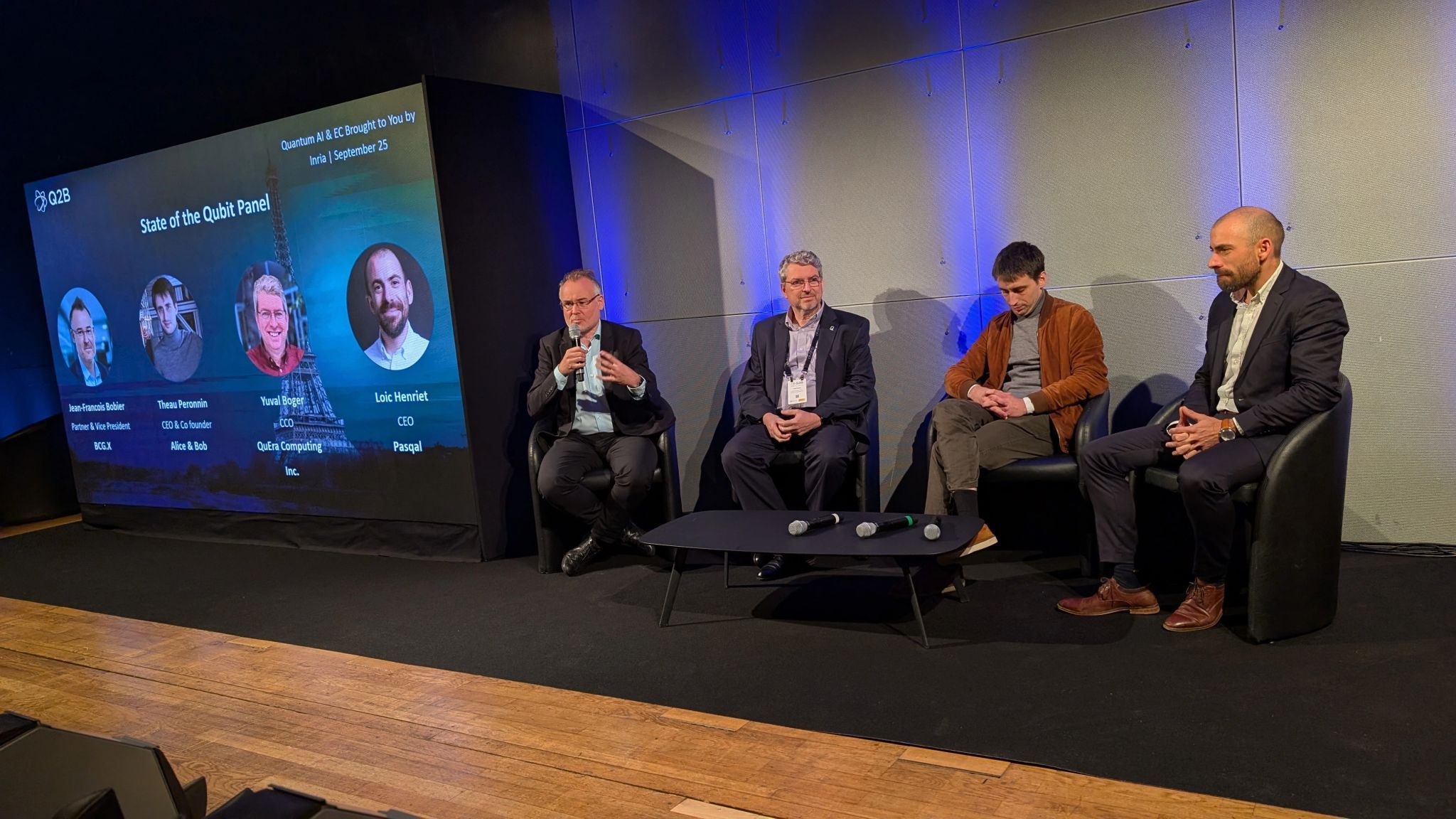One of the many challenges facing quantum computing is a lack of standardized terminology. Here we can identify five definitions for just one term. And although they vary quite a bit in popularity, they are all actively in use.
In a Forbes article titled “The Quantum Revolution Is Here, Its Name Is Hybrid,” hybrid quantum-classical computing is defined simply as a quantum computing system working in harmony with a classical computing system. Multiple classical computers get data to the quantum processor, control the control system, read out the measurements, enable cloud accessibility, and more. The quantum processor only performs computation and, therefore, is of little value without these classical systems fully integrated as hybrid computing systems. It’s worth noting that quantum error correction (QEC), which is essential for fault-tolerant quantum computing, requires the application of classical logic.
In another definition, the classical systems are not just standard classical computers, even though some remain involved. This definition is referring to the incorporation of high performance computing (HPC) in a way that creates two sub-definitions of this term. One sub-definition refers to leveraging HPC to accelerate some or all of the aforementioned classical tasks. But, a second sub-definition refers to leveraging HPC to accelerate the classical subroutines of hybrid classical-quantum computing algorithms, which are also referred to as variational quantum algorithms (VQA).
This segues into another definition, which refers to these variational quantum algorithms, not to the use of HPC systems. These hybrid classical-quantum computing algorithms consist of parameterized quantum circuits, which run on real quantum computers or quantum computer simulators, and classical neural networks, which train and update the parameters. For this purpose, the quantum computer and supercomputer ought to be in the same datacenter, minimizing latency in the computation. However, long-term roadmaps envision applications in which HPC is not merely playing a supporting role, and that cloud-based HPC resources will contribute in other ways to enterprise-class hybrid applications.
Yet another definition is hopefully migrating to a new term: integrated hybrid computing. Both terms overlap a third term: dynamic quantum circuits. Whichever term is used, the meaning is that a classical control system reads out measurements, performs some classical conditional logic at the quantum processor level, and then executes the next series of quantum operations based on the results of these so-called mid-circuit measurements. The key differentiator between this definition and the first definition is that some classical logic is executed at the quantum processor level as one run of a quantum circuit, which is faster than non-hybrid, non-integrated, non-dynamic approaches that execute multiple runs of quantum circuits. Another major benefit of using one quantum circuit is that quantum information can be preserved on qubits on which mid-circuit measurements are not applied, whereas quantum information is lost in between runs of multiple quantum circuits.
Finally, our last definition comes from Our Quantum Roadmap, which refers to a hybrid digital-analog approach to quantum computing. A digital approach, also known as gate-based or gate-model quantum computing, is the more user-friendly of the two approaches. However, quantum computers are analog, continuously transforming quantum states. The end goal is to provide a user-friendly gate-model interface that translates gates into continuous operations, thus decelerating the accumulation of gate errors and enabling precision control over larger numbers of qubits.
No matter which of these definitions we choose, there is one common theme among all of them. Classical computing will always be integrated into quantum computing, even though the reverse of this statement is not true. In quantum computing, though, our best results will come from combining the strengths of these two very different technologies.
What is Hybrid Quantum Computing
Among the five definitions, the most popular is probably the third one, specifically the use of parameterized quantum circuits. Classical neural networks are used to train and update the circuits’ parameters. These algorithms have been popularized, in part, due to their versatility in solving a wide range of problems, but also due to their ability to run on near-term Noisy Intermediate-Scale Quantum (NISQ) computers. Researchers from around the world are exploring if they have potential to deliver practical utility for real-world problems. It is important to always remember that the term variational quantum circuits refers to the same thing.
The second most popular definition is probably the last one, blurring the lines between digital and analog models of quantum computing. The digital model is the more popular of the two, thanks to its ease of use and widespread availability. However, researchers and enthusiasts alike lament the associated high error rates. If the ease-of-use of the digital model can be combined with the performance of the analog model, this would represent the best that both worlds have to offer.
No matter the definition, the end goal of everyone involved is to find utility in quantum computers within the constraints that are currently imposed.
{{Newsletter-signup}}
Challenges in Hybrid Quantum Computing
Classical computing has been introduced to quantum computing as a means to overcome some of the challenges of the latter. However, the former brings with it some of its own challenges, and the integration of the two introduces new challenges, as well.
- Control. The Forbes article notes that controlling large entangled systems is especially challenging, and that the timescale is long before enough qubits are available to perform useful computation.
- Parameters. A paradox of parameterized quantum circuits is that as the circuits scale up in size, and as the number of parameters grows with it, the challenge of classically optimizing those parameters increases, as well. Our article titled “Quantum Simulation - Key Challenges and Effective Solutions” notes that this classical challenge in one of the reasons for investment into quantum computing in the first place.
- Errors. This article further notes that quantum simulation with digital quantum computers requires fault tolerance, referring to error rates that are as yet far away.
- Evolution. The same article further notes the simulation of quantum systems requires a level of precise control that is not currently achievable with digital quantum computing. The solution to this, however, is analog quantum computing.
- In a paper titled “The inherent problem in quantum simulations — and how to tackle it,” Jukka Knuutinen and Dr. Ljubomir Budinski of Quanscient address a fundamental problem facing algorithms. Quantum mechanics is natively linear, but many of the problems that need to be solved involve non-linear equations.
- Enterprise-class. While classical computing has found its way into quantum computing, the reverse still needs to be demonstrated, the incorporation of quantum computing into enterprise-class applications.
- Integrations. Seamlessly connecting quantum computers and HPC resources, or even quantum computers and other quantum computers, needs further research and development.
- Data loading. While quantum computers can exponentially compress classical data, it remains an open question as to how to efficiently do this.
- Validation. Classical systems are in used to validate the solutions generated by quantum computers. It remains an open question as to how some of this will be done as quantum computers become used for classically-intractable problems.
- Distribution. As systems become more integrated, determinations will need to be made as to when to use quantum processing and when to use classical processing.
- Resources. In addition to increasing the amount of quantum computational resources available, new algorithms are needed that require fewer resources.
- Software. Existing tools to develop hybrid quantum applications themselves require tremendous classical computing resources, especially memory.
- Advantage. Algorithms need to be developed that can not only demonstrate advantage over classical algorithms, but that can withstand challenges from quantum-inspired algorithms.
- Education. The workforce of the future needs the skills to develop hybrid quantum applications with computational advantages.
- Standardization. Interoperability, whether of hardware or software, will require a degree of standardization that hasn’t even begun yet.
It is important to note that none of these challenges appear to be insurmountable. Solutions will require collaborations across academic, industrial, and government sectors. The effort will be worth it, however, as the solutions will help to unlock the full potential of quantum computing.
Applications of Hybrid Quantum Computing
The use cases of hybrid computing systems are no different than those listed in our article titled “Top Applications Of Quantum Computing for Enterprises.” At a high level, there are only a small number of classifications.
- Finance, including risk assessments, modeling, and options pricing
- Machine Learning (ML), including training acceleration and large dataset analysis
- Material Science, including molecular simulations, drug discovery, catalyst design, battery and solar cell development, and weather forecasting
- Natural Language Processing (NLP), including general artificial intelligence (GAI)
- Optimization, including supply chains, inventories, financial portfolios, logistics routes, location selection (maximum independent set)
The number of use cases being researched is much higher than this. But, again, these use cases fall under these classifications.




.webp)





